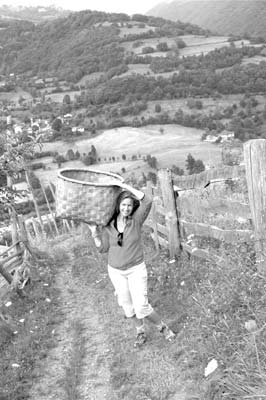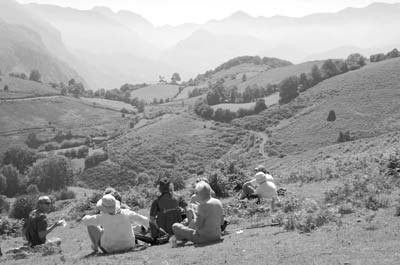Northern Spain’s Celtic roots
I took a trip to northern Spain, Aug. 8-28, 2007. Guitars, wine and arid plains, right? Yes, in other parts of Spain, but in the principality of Asturias, located on the coast between Galicia and Cantabria, bagpipes, apple cider and mountains are standard fare.
Upon arrival at the Aviles airport in Asturias, the most remarkable sighting is the triskele, an ancient Celtic symbol, which marks everything. T-shirts, shot glasses, jewelry and wood all are painted, pressed and carved with the triskele’s three spirals.
The three spirals represent the three aspects of a power. The fact that they are spirals signifies motion and purpose. For example, time as past, present and future. Another example — human existence including body, emotion and spirit, seen projected outside of ourselves as earth, water and sky.
So what is the triskele doing in northern Spain? How did the Spanish end up with a Celtic emblem?
A look through the area’s turbulent history shows that, of dozens of newcomers, Celts are the only ones who joined with and supported the fine people and lands of Asturias instead of pillaging and plundering (think Romans).
Celts made a home there around the same time they settled parts of the British Isles and northwest France, among many other localities. And many contemporary Celts, including Asturians, are nurturing and honoring ancient heritage.
Celtic art belongs and is present throughout Asturias, from beneath the wood beams of the hórreo, ancient Roman granaries, to the evening air as the neighbor boy practices his Asturian bagpipes.
While Celtic influence is obviously carved deeply into the framework of the area, Asturias is also the true home of Spanish culture. There in the lush green mountains of northern Spain, the Spanish language is spoken more purely, local apple cider is poured from higher overhead (for perfect aeration), and the ancient Roman roads and Spanish hamlets are the best-preserved of all of Spain.
Cattle, sheep and horses roam free. Bells on their collars tinkle softly as they browse. Dogs and cats patrol the village. And nearly every meadow holds a burrow, his morning brays welcoming the sun.
In long stretches of sunny days, the verdant valleys are kept green thanks to perfectly interspersed visits of rain. During the rain, the fauna find shelter deep in forests of chestnut and mountain ash which frame the valley floors. These forests roll up against the very foot of the towering limestone walls.
Kin to but separate from the woods, the sprawling oak and expansive yew are deciduous sentinels throughout the high and low valleys. Protected by their grand boughs is often a tiny, bell-towered chapel.
The Quirós Valley, in the region of Asturias, northern Spain, offers a natural paradise enhanced by antiquities of Celtic, Roman and Spanish culture. During my holiday there, sitting quietly with the tree/chapel pair, listening to a stream and considering the clouds was my favorite thing to do.
I took this all in during a delightful one-week walking adventure guided by Judy Colaneri, owner and operator of Spanish Steps Adventure Walking Tours (Box 8653, Aspen, CO 81612; 877/787-9255, www. spanishsteps.com).
The cost, including seven nights of lodging and eight days of guiding plus breakfast and one main meal each day, was around $1,000.
A lovely guide and host, Judy is gifted in the kitchen, on the trail and in planning and communicating. She is an American and her husband, Juan Carlos, is a Spaniard. Together they recently established a bed-and-breakfast, called Fuentes de Lucia, in a tiny hamlet within the Quirós region of Asturias.
Judy and Juan Carlos offer guided local experiences, including walking, bicycling, mountaineering, rock climbing, horseback riding, massage, yoga retreats, writing workshops and cultural explorations (from 10th-century churches to trailside taverns).
I took a side trip to the eastern corner of Asturias, into the even more mountainous region of Picos de Europa. From the village of Arenas de Cabrales, mountaineering, hiking, rock climbing and cheese-sampling forays were abundant. This Picos region has higher, sharper peaks and more developed tourist destinations compared to the Quirós, which is enjoyed more for its verdant valleys and relic hamlets.
Good contacts in Arenas include Jorge Granda Aguado (jorgentrya@hotmail.com), a native Spaniard, English-speaking philosopher, historian, wild crafter (he enhances evening meals with culinary herbs picked during the day’s hike) and guide; John Rogers (john@picos-guides.com or www.picos-guides.com), a colorful Englishman, transplanted to Spain via Wales, multiday tour outfitter and guide, and Neil Abbott (neilylad@hotmail.com), the man in town for yoga, energy work or massage.
All manner of water, rock, trail and equestrian sports are available through these folks in Quirós and in the Picos. Rates for a guided mountaineering trip in the Picos, all support included, run about $130 per person per day (an estimate based on a 10-day package for three people).
Judy and the others are amazingly friendly and welcome your holiday ideas and preferences.
PEG O’BRIEN
Woody Creek, CO


